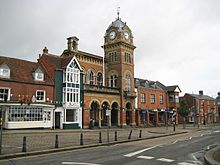Hocktide
[3] Some evidence allows us to see that Hocktide was considered an important festival in some parts of Late-Medieval England, and was a chance for the women of the parish to raise money for the local church.[4] George C. Homans notices the parallel pattern as at Christmastide, of a solemn feast of the Church, that of Christmas itself, followed by a festive holiday, with the agricultural round beginning anew after Epiphany, with the folk customs of Plow Monday.[3][1] Until the 16th century, Hocktide was widely celebrated in England after Easter, although the massacre of the Danes in 1002, by order of King Ethelred the Unready, took place around the feast of St Brice, on 13 November and Hardicanute's death in 1042 occurred on 8 June.The festivities were banned under Henry VIII as they were thought to encourage public disorder, but Elizabeth I was petitioned to reinstate the tradition in 1575, an event recorded in Sir Walter Scott's Kenilworth.Despite a legal battle during the reign of Elizabeth I (1558–1603) when the Duchy attempted to regain the lucrative fishing rights, the case was eventually settled in the townspeople's favour after the Queen herself interceded.The Hocktide Council, which is elected on the previous Friday, appoints two Tutti Men whose job it is to visit the properties attracting Commoner's Rights.
medievalWhitsuntidetwelve daysChristmastideweek following Eastervilleindemesneterm dayMichaelmasEpiphanyCoventryReformationQueen ElizabethKenilworthmassacre of the DanesSt. Brice's DayHarthacanuteEthelred the UnreadySt BriceHenry VIIISir Walter ScottOld EnglishHungerfordwatercressWelsh rarebitHungerford Town HallDuchy of LancasterJohn of GauntDuke of LancasterRiver KennetTown crierTown HallclovednosegaysorangesRadonitsaGeorge C. Homanspublic domainChisholm, HughEncyclopædia BritannicaEnglish festivalsPlough MondayMothering SundayMother's DayEasterSt George's DayLammasHalloweenSoulingGuy Fawkes NightChristmasWell dressing
